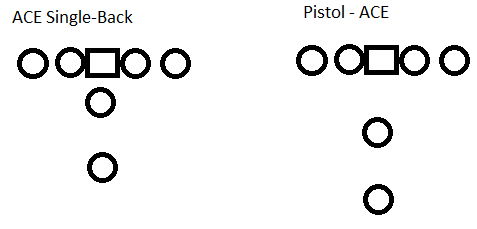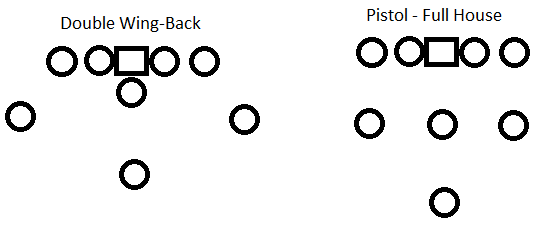NCAA 14: A Guide to the Pistol Offense
Hello TSO. My name is Ken Mooney, I am High School WR/DB’s coach and I have been given the opportunity to break down the Pistol Offense (PO). I have been using the PO since EAS first implemented the offense in NCAA Football, and I have the pleasure of coaching the offensive scheme as well.
The PO first came onto the college football scene in 1999, at Ohio Northern University (DIII). The purpose of the offense is to allow the running back to keep their initial steps in the running game, while keeping the QB comfortable in the passing game. How does it accomplish this?
The Base formation is similar to a single back - the QB lines up four yards behind the center (shotgun is typically 6-7) and the running back lines up 3 yards behind the QB. By having the QB lineup in a semi-shotgun position, they are able to keep distance from the line-of-scrimmage –better for the passing game. By having the running back directly behind the QB, the running back is able to get their initial steps for a down-hill running game. Below are the positions in the offense:
QB – QB
RB – B (typically behind the QB)
RB – H
RB – HH
WR – X
WR – Z
TE – Y
Skill Player –A (I consider this the Theo Riddick type. Can run, jet, and catch.)
Basic Strategies
The beauty of the offensive formation is that you can run a hybrid of almost any other formation. Below is a formation comparison within the tackles (excluding TE’s and WR) *there are other formations, but below are the most typical. These are three of the ten variations you might see in a PO offense.



As stated earlier, the primary RB in each formation is put in position for a down-hill running attack. Take a look at the Full House compared to the Wing-Back formation. A basic triple option comes from the Double Wing setup – which typically require a player to go in motion (unless it is a speed option).
In the Pistol Full House, no motion is required because the ‘wing-backs’ are lined-up inside the tackles, instead of outside. This makes it very difficult for defenders to make a read on the play –No motion and: the QB can keep, ride the B, Ride the H or HH –all within a second and without there being a motion hinting at the play side.
Typically in a shotgun formation, the running attack either has the RB running towards the opposite side they lineup on, so that they may gain momentum or it’s a speed-option. In the PO the RB can go: Left, Right, Outside, inside –All, while gaining first-step momentum. This is because the RB is lined up directly behind the QB.
Because the QB is four yards behind center, the passing game and timing routes differ from a typical shotgun or under center formation. Passes can come-out quicker because the QB isn’t taking the 5-7 step drop back. Or can be delayed because of the QB’s location within the pocket.
Pros
- Primary RB behind QB
- Primary RB can run each-side, inside all while getting first steps
- Difficult to defend option (no pre-snap motion)
- Timing routes differ
- QB takes less time dropping back, allowing for easier down field reads
- LOADED With Skill Players Requires more than the front-seven to stop (safeties typically have to come-up to stop the run)
Cons
- No much of a power running attack
- Running attack is slightly delayed because of the semi-shotgun snap
- Requires players with multiple skill
- QB will get hit…A lot
- Requires great depth in the running game
Recruiting for the Pistol Offense
While there are many variations to the pistol offense, this is how I like to recruit for my scheme:
- QB – Speed and arm accuracy. You will want a guy who can kill with feet and hit the slants, outs, bubbles, arrow and the 5-step post.
- B – You best running back. To setup a strong 15/14 read your best back needs to be in the back field, acc and agility will be important. One cut backs are best.
- H – has to be a decent runner, blocking and receiving will be his primary objectives. I would actually consider moving a smaller sized TE to this position
- HH – Your third best running back, whatever it is you would like to groom
- A – Your best athlete. He is going to line up in the slot primarily; he will go deep, bubble, run jet. You can use a receiving back and I would find a short burner at receiver.
- X – Primary receiver! I am throwing the ball up and he is the one coming down with it. 6ft2 or <. Release, catch/spec catch and jump
- Z – quick, able to create space between him and the DB. Speed and Acc, height is not that important.
- Y – However you like to use the TE. Personally, I like to have a receiving and a block TE in my depth chart, that way I can package them when/where necessary
That about wraps it up. I hope I have convinced you to try the pistol this year! If you have any questions, please leave them in the comments section!
Article by: RadarRider

